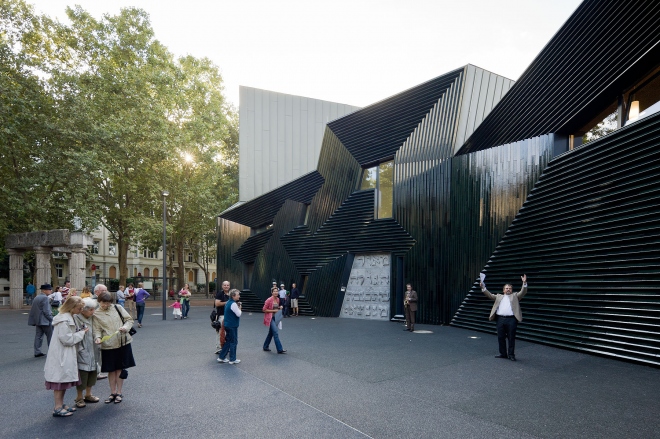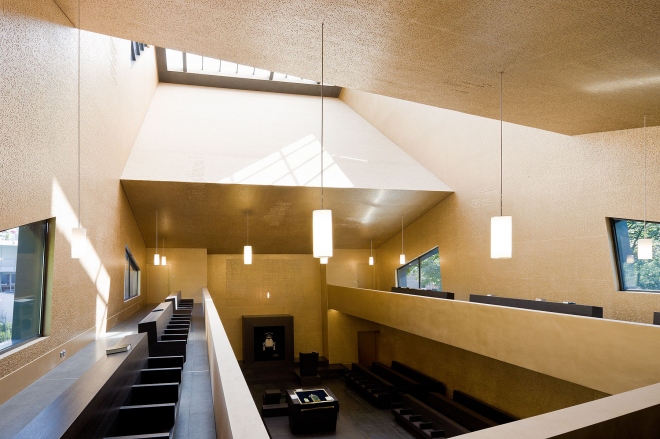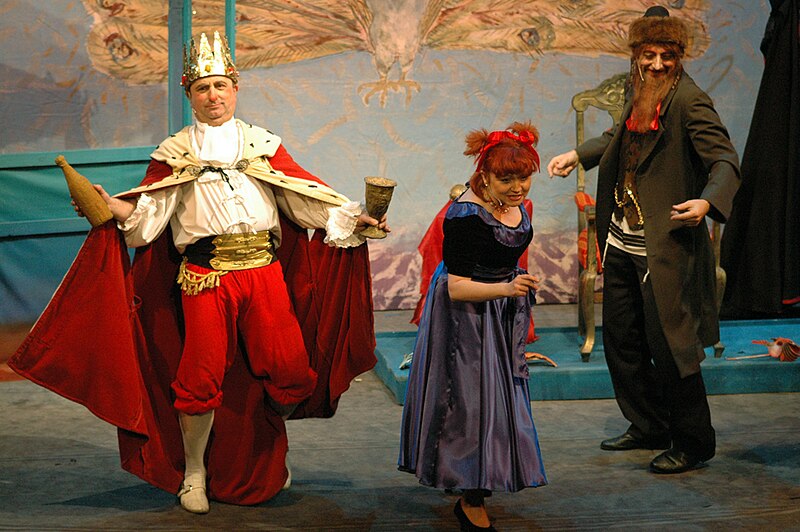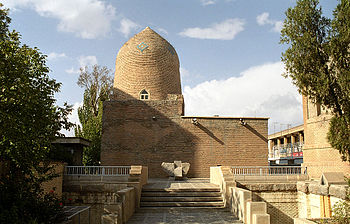As reported by Core77 blog, the Design Museum Holon hosted a design week for an impressive line up of designers from around the world. Kind of a design summer camp, the program gave the designers a firsthand look into what it means to design for Israel today, a country where good design has often taken a backseat to more utilitarian needs. Read about the design week at Core 77 blog here.
You can read more about some of Israel's young designers and their designs at a follow up segment on the Core 77 blog here.
JewSD
The official Jewish student group of the GSD
Monday, April 23, 2012
Thursday, March 29, 2012
Synagogue in Mainz by Manuel Herz
Nominated for the Mies van der Rohe Prize for European architecture in 2011, the Mainz Synagogue by Manuel Herz represents the bold rebuilding of the Jewish community in Mainz, Germany. A Jewish presence has existed in Mainz for at least a millennium and produced many religious scholars, but over that period the community has been periodically eradicated and refounded.
The new synagogue and community center is the latest communal revival and is built on the site of the former synagogue. Unlike many synagogues designed in the post Holocaust era that try not to draw too much attention to themselves, the Mainz Synagogue offers an urban square in front of the main entrance.
See the project described in greater detail on Manuel Herz Architects' web site here.
Monday, March 5, 2012
Harvard Purim 2012 Event Guide
Purim is Wednesday night March 7th through Thursday March
8th
The Fast of Esther starts Wednesday, March 7th at 4:45am and
ends at 6:10pm
Purim with Hillel
52 Mt. Auburn Street, Cambridge
Megillah Readings*
6pm Wednesday night, Thursday morning at 6am and 8am
Women's Megillah reading* at 7:30am
*Please bring a box of pasta to use as a grogger and to be
donated afterwards to Harvard homeless shelter
Purim Seudah -
JLIC/Student Conservative Minyan/Orthodox Student Minyan
Meal - Thursday 12:30-2:30 (all are welcome)
Purim-Run: A Purim Celebration with SCM
Join the SCM community for a river-run themed megillah
reading and raucous Purim celebration on Wednesday March 7th, at 7pm, Ticknor
Lounge. Come dressed as your favorite
house mascot.
Worship & Study Minyan Purim Celebration
Join W&S for Megillah Reading, a Hamentoshen Bake Off,
and original minyan-produced entertainment.
From 7:00pm - 9:00pm in Smith Hall.
Tremont Street Shul
8 Tremont Street, Cambridge
Egalitarian evening service with Megillah reading -
Wednesday 6:30pm
Traditional Evening service with Megillah Reading -
Wednesday 8:30pm
Minyan Tehila
(all events at Casa Do Benfica, 178 Elm Street, Cambridge)
(all events at Casa Do Benfica, 178 Elm Street, Cambridge)
Purim davening and Megillah - Wednesday 6:25pm
Party and Megillah with Cambridge Minyan - 8:15-9:15
Late Megillah Reading - 9-10pm
Harvard Chabad's ABSOLUT PURIM 2012
The Crimson Bash -
THE BEST PARTY OF THE YEAR!
Wednesday 3/7 at the Harvard Crimson
8:30 Megillah Reading / 9PM AWESOME PARTY!
Hot food buffet, unlimited Hora, and incredible spirit.
Bagels, Lox and Megillah Brunch
Thursday, 3/8
12PM - Harvard Law School - WWC B015
12:15PM - Harvard Business School - Aldrich 208
Brought to you by Harvard Chabad, JLSA and the JSA
A Royal Feast
Thursday, 3/8 at Chabad
Last Chance to hear the Megillah at 4:30PM
Full spread festive dinner with lots of Chabad spirit 5PM
RSVP info@chabadharvard.org
Chai Center
Purim Party
Chai Center
Purim Party
Club Rumor, 100 Warrenton St. Boston
Purim party for 20s/30s young adults
Megilla Reading
$15 pre-register, $20 at the door
Register here
Purim!
Purim is Judaism's most festive holiday. It commemorates the Jewish people's deliverance from a genocidal plot to destroy them hatched by the evil Haman in the ancient Persian Empire. Like some other Jewish holidays, Purim can be summarized as: "They tried to kill us, they failed, lets eat!"
Purim is celebrated in many ways. We read of the Megilla, a scroll that recounts the story of Purim. It is also traditional to the give gifts of food and drink to our friends and money to the poor. Purim is also celebrated by wearing masks and costumes, and copious amounts of drinking, eating, and partying. A traditional Purim snack is a Hamantashen, a triangular shaped pastry filled with jam.
Purim is Wednesday night March 7th through Thursday March
8th .
The Fast of Esther starts Wednesday, March 7th at 4:45am and
ends at 6:10pm
Check out some of the Purim festivities happening in and around campus here.
To learn more about Purim visit the following resources:
Also check out this video of tomb of Mordechai and Esther, the heroes of the Purim story, here. The site is located in present day Iran.
Wednesday, February 29, 2012
Where Do You Give? Competition Deadline
Deadline extended to March 9th!
Where Do You Give? challenges artists, designers and conceptual thinkers to create an updated vehicle for giving in the 21st century that inspires a national conversation among all of us who seek to engage more deeply with our communities—be they geographic, ethnic, national or other—about where we give, to whom and why.
Use art, design and technology to change the way Jews think
about giving tzedakah. Where Do You Give asks artists and innovative thinkers
to reimagine tzedakah for the 21st Century.
Enter the competition today for a chance to win $2500, travel with AJWS.
Go to www.wheredoyougive.org to submit a
design that sparks a national conversation about giving.
Where Do You Give? challenges artists, designers and conceptual thinkers to create an updated vehicle for giving in the 21st century that inspires a national conversation among all of us who seek to engage more deeply with our communities—be they geographic, ethnic, national or other—about where we give, to whom and why.
Reimagine the
tzedakah box—an ancient ritual object used to collect money for
charitable causes—and you could win $2500, be featured in a national
exhibit and have an opportunity to travel internationally to meet with
some of AJWS’s grassroots partners. Watch this
video or go to
www.WhereDoYouGive.org to learn more.
Monday, February 27, 2012
Wednesday, February 22, 2012
Gavriel Rosenfeld on Jewish Architecture
Gavriel D. Rosenfeld, associate professor of history at Fairfield University, has written a book entitled Building After Auschwitz: Jewish Architecture and the Memory of the Holocaust published by Yale University Press. A couple months ago, he sat down with the book's publishers for an interview on the meaning of the term 'Jewish Architecture' and the effect that the Holocaust had on Jewish design. Some excerpts:
Yale University Press: How do you define “Jewish architecture”?
Gavriel Rosenfeld: Jewish architecture does not exist in any stylistically recognizable sense. Historically, the divergent experiences of Jews living in the diaspora prevented the emergence of a unified “Jewish style” of building. Still, the buildings built by, and for, Jews over the centuries have exhibited Jewish traits in the myriad ways that they have reflected the historical forces that have shaped Jewish life. Some of these forces have impacted the buildings used by Jews in indirect fashion. In other instances, Jews have made deliberate efforts to draw on their cultural and religious traditions to infuse their buildings with a sense of Jewishness. I prefer to think of Jewish architecture expansively, as buildings that express the Jewish historical experience.
YUP: How did the Holocaust affect Jewish artistic production, and architecture in particular?
GR: Jews in all fields of creative endeavor have been shaped by the legacy of the Nazi genocide, although not in the same way and certainly not at the same time. While writers, poets, and painters, for example, began to wrestle with the Holocaust’s significance in the early years after 1945, architects by and large refrained from doing so until the 1980s. Thereafter, the Holocaust’s legacy made itself felt in a variety of ways: in the deconstructivist movement, Holocaust museums, and even synagogue design. Overall, Jewish architects, like other creative figures, have struggled with the problem of how to represent the Holocaust in their work. The architectural responses to this aesthetic and ethical challenge have been diverse and they are notable for breaking new ground both in the history of Jewish architecture and western architecture more broadly.
YUP: What are the greatest challenges that Jewish architects have faced in the past, and how are they dealing with these issues today?
GR: For centuries, Jews faced major obstacles in breaking into the field of architecture due to guild restrictions and other professional barriers. This gradually changed with the onset of emancipation in the 19th and 20th centuries. Today, Jews face few such hurdles. Yet until recently, they were generally dissuaded from, and were inhibited about, expressing a sense of Jewishness in their work. Since the 1960s, however, the rise of multiculturalism and postmodernism in the west has liberated Jews to draw on Jewish sources of inspiration in their designs. This new sense of creative freedom has allowed some Jewish architects to attain unprecedented accomplishments and, at the same time, has made the architecture of Jewish architects more “Jewish.”Read the entire interview on the publisher's website:
http://yalepress.wordpress.com/2011/11/22/gavriel-rosenfeld-on-jewish-architecture/
Subscribe to:
Posts (Atom)










